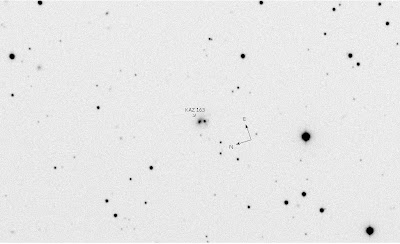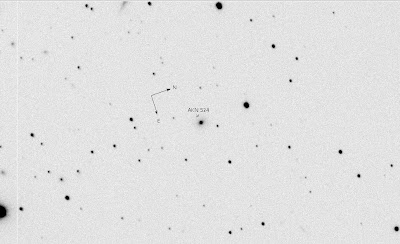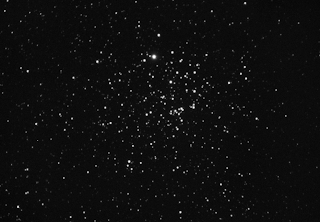AstroBilly's Solid Angle
An Astrophysicist corner
Thursday, January 30, 2014
Cadwell 10 (NGC 663) and Open Cluster and Be stars
The Open Cluster known as C10 or NGC 663 is about 2100 parsecs from us towards the constellation Cassiopeia. Its estimated age is around 20 million years. Therefore its main sequence B2 stars are coming to the end of their life cycle. It is of great interests to astronomers due to its large number of Be stars. These stars are interesting due to the strength of their emission lines and their typical infrared excess. Here I present an RGB image composite of this cluster as taken from my telescope at the Vazquez Astronomical Observatory. Just another wonder in the Universe at the reach of us here in Webster, NY.
Thursday, January 2, 2014
M 81 Bode's Galaxy
 |
| M 81 Bode's Galaxy as seen by VAO |
Wednesday, June 5, 2013
Observations of Active Galactic Nuclei - 06/03/2013
VAO (Vazquez Astronomical Observatory) - 06/03/13
Sky conditions: CLEAR and DARK
Telescope: Meade 12"
Focal Reducer: f/6.3
Camera: QSI 632wsg - KAF3200ME
Guiding: Starlight Xpress Loadstar - ICX429AL
Twilight V Flats
Filter: Johnson/Cousins V
* Note: All stellar profiles are in counts in the vertical and pixels in the horizontal axis. Images are cropped with the target at the center.
* Note: All stellar profiles are in counts in the vertical and pixels in the horizontal axis. Images are cropped with the target at the center.
NGC 6418 - 15x120s - median combined
Sky background mean counts: 193 +/- 1.67
Inst. magnitude: 5.430 +/- 0.031
Sky background mean counts: 193 +/- 1.67
Inst. magnitude: 5.430 +/- 0.031
 |
 |
PGC 61965 - 10x300s - median combined
Sky background mean counts: 834 +/- 4.83
Inst. magnitude: 4.089 +/- 0.017
MRK 876 - 5x300s - median combined
Sky background mean counts: 463 +/- 6.22
Inst. magnitude: 3.749 +/- 0.011
MRK 885 - 17x120s - median combined
Sky background mean counts: 119 +/- 1.33
Inst. magnitude: 5.621 +/- 0.032
MRK 507 - 5x300s - median combined
Sky background mean counts: 372 +/- 3.36
Inst. magnitude: 4.214 +/- 0.014
KAZ 163 - 5x300s - median combined
Sky background mean counts: 244 +/- 2.18
Inst. magnitude: 5.034 +/- 0.024

KAZ 102 - 5x300s - median combined
Sky background mean counts: 237 +/- 2.20
Inst. magnitude: 5.724 +/- 0.043
3c390.3 - 5x300s - median combined
Sky background mean counts: 189 +/- 1.38
Inst. magnitude: 4.884 +/- 0.020AKN 524 - 5x300s - median combined
Sky background mean counts: 112 +/- 1.08
Inst. magnitude: 5.727 +/- 0.034
Friday, August 17, 2012
M74 a Grand Design Galaxy
 |
| M 74 5x2 min expousres binned 2x2 @ f/10 12" SCT © Billy Vazquez |
M74 is a beautiful galaxy on the constellation Pisces. The image presented here was taken at VAO in the morning of August 16th. They are 5x2 min exposures binned 2x2 on Johnson R filter at f/10 on the 12" SCT. FWHM for the night averaged 2.7". Bradon Doyle generated interest in this galaxy and we collaborated to obtain this image for scientific research. The image was colorized in GIMP but no streching or other post-processing effects were added. The image was callibrated with darks and flat fields. The image was taken on a cooled KAF8300 CCD cooled to -10 degrees Celsius.
Monday, August 13, 2012
Orion Parsec KAF8300 CCD Linearity Test
 |
The main camera of the VAO is an Orion Parsec that has a KAF8300 CCD. One of the issues with this camera is the possibility of non-linearity as it fills the pixel electron well. The KAF8300 uses Anti-Blooming circuitry to drain current as the pixels fill up. This has the desirable effect of eliminating blooming from bright stars in your image while increasing your dynamic range. The downside of this technology is that it lowers the quantum efficiency of the CCD since there is additional electronics in each pixel to drain the current out. More importantly, it adversely affects photometric measurements as the pixel fills up. The measurements at higher ADU counts will show non-linear response. Therefore, in an attempt to quantify these deviations from linearity for my camera, I have performed a linear test. The test is simple enough. Take flat exposures of increasing time steps and plot the counts vs time as you can see from the plot I present here. Notice that the asymptotic error of the linear fit is of the order of 0.39% or about +/- 12 ADU.
Thursday, August 9, 2012
M 52 an open cluster but how far is it?
 |
| M 52 3x5 minute exposure, Stromgren y © Billy Vazquez |

Friday, August 3, 2012
Maia a Star in the Pleiades Cluster
 |
| Maia in Pleiades 5 min unguided exposure © Billy Vazquez |
Subscribe to:
Posts (Atom)


























